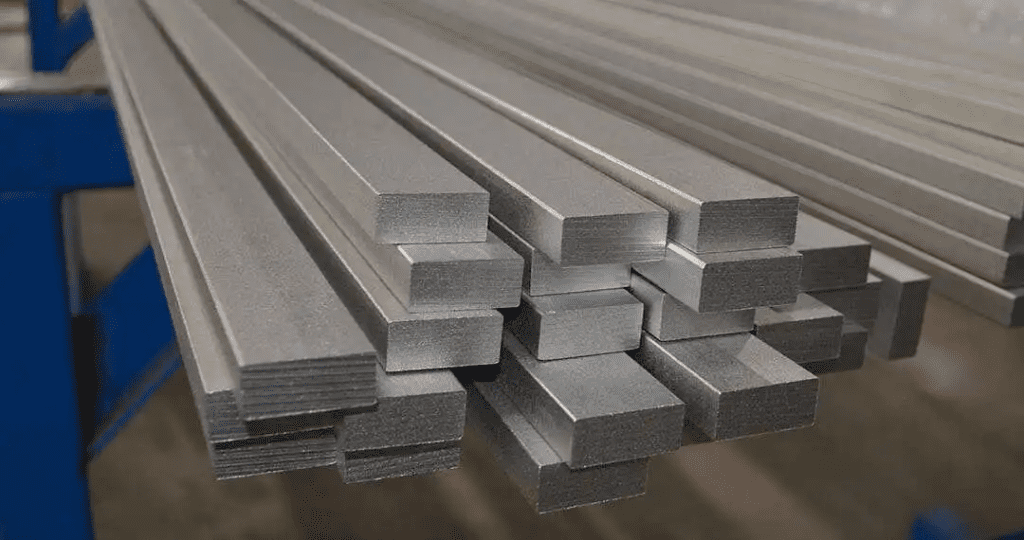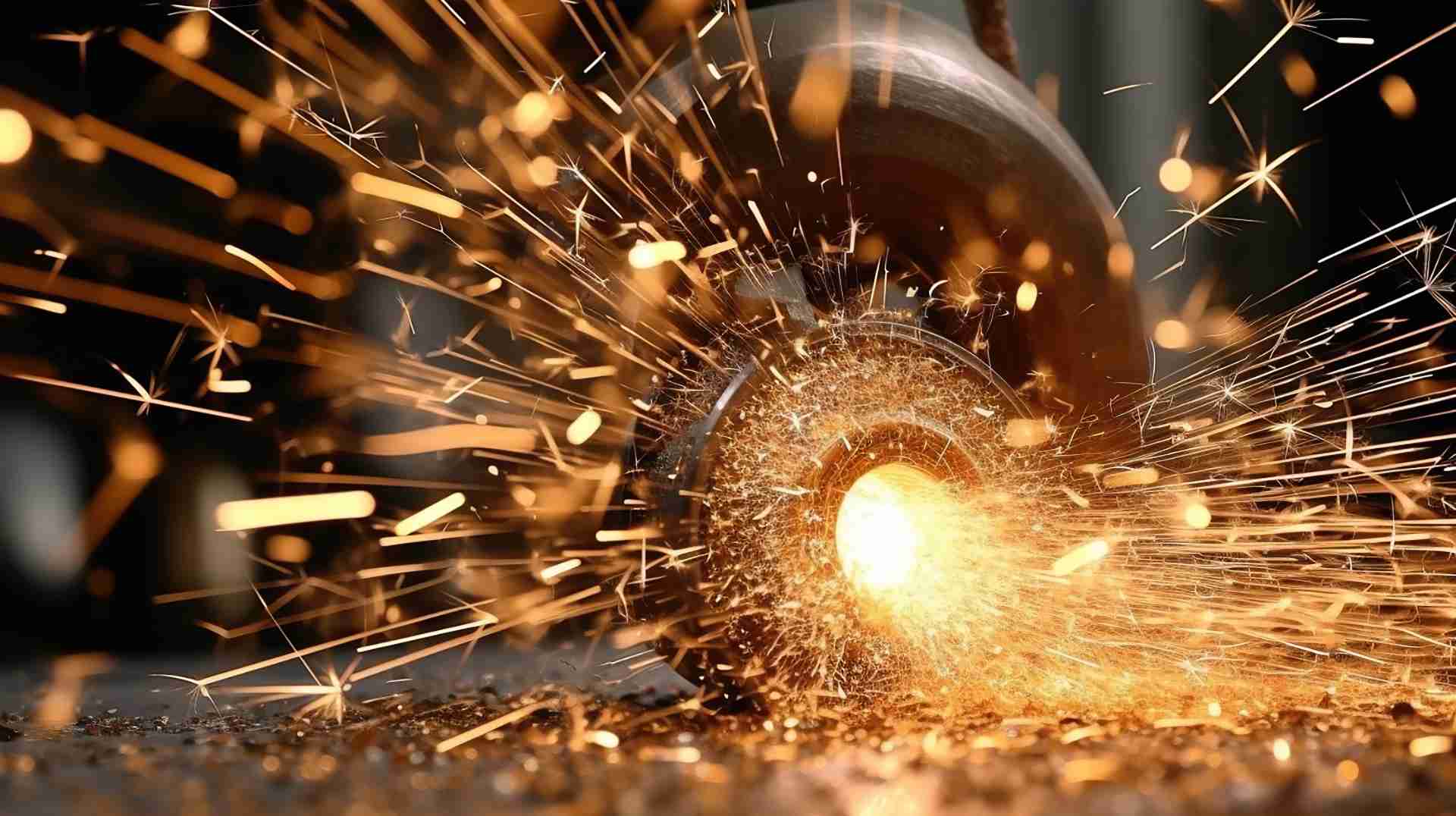Modern industry uses a lot of volatile chemicals that can become mixed with the atmosphere of the working environment. If a spark is then introduced into this fuel-air mix, it can combust, creating a fireball worthy of a Hollywood movie.
Non-sparking or spark-resistant tools and equipment are vital to working within these environments. Making this equipment requires metals that don’t produce sparks, or at least don’t produce sparks that are hot enough to initiate combustion.
Learning what metals don’t spark depends on where and how they will be used. Spark resistance is due to a range of different properties, and these properties aren’t the same across all metals. A metal that doesn’t spark in one instance may be hazardous in another.
Why Do Metals Spark?
When we refer to sparking metal, we are really referring to the combustion of elements within the metal, if not the metal itself. This can be caused by the input of energy in the form of heat or mechanical action – kinetic energy – this energy input causes the breaking of chemical bonds in the metal, allowing the elements exposed to react with oxygen in the air and oxidize, or effectively experience a tiny explosion with lingering light and heat.
In thermally conductive metals like aluminum, the excess heat is dumped well before it can reach the combustion point. The metal is also soft enough that it becomes mechanically separated before the energy input needed to cause combustion is ever reached.
Sparking is observed most often in steel; steel is the most dangerous sparking metal in combustible environments due to a few factors
Why Is Steel the Metal That Sparks the Most?
| Iron readily oxidizes | The process of oxidation is actually energetic enough to make small pieces of iron glow or create sparks |
| Steel is an alloy of iron and carbon | The carbon can actually oxidize before the iron, creating carbon monoxide and carbon dioxide |
| Carbon oxidizing can break apart small pieces of steel into smaller pieces | This exposes more iron and carbon to the atmosphere. This is why sparks from steel are often observed splitting at the end of their arcs |
Sparking, or combustion, in steel is a limited, self-propagating phenomenon. A limited input of energy can result in a great many sparks that split into new sparks. While it isn’t a self-sustaining reaction and will eventually stop if the energy input stops, it can be quite dangerous in flammable or combustible environments. Instead, the use of spark-resistant metals for tools and equipment like fans is a priority.
What metals don’t spark is highly conditional. For example, if enough energy is input into a small enough piece of aluminum, for example, aluminum foil in a microwave, it can and will spark. The same is true for all spark-resistant metals.
What Metals Don’t Spark, and Why?
So, what metals don’t spark? The common list given is nonferrous metals like copper – this is one of copper’s many unique uses in industry – aluminum, silver, and lead, along with alloys of copper like brass, bronze, and cupronickel alloys like Monel. This list of spark-resistant metals includes metals that don’t spark due to their thermal conductivity, shedding energy inputs quickly and keeping them below the threshold for combustion like copper, aluminum, and silver.
Metal Softness Impacts Sparking
In the case of lead, which isn’t thermally conductive in any sense of the word, the explanation for why it is a non-sparking metal is its softness. It sheds impact energy by deforming and mechanically breaking apart before the energy reaches the threshold needed for combustion.
To a certain extent, this applies to thermally conductive metals as well. With the exception of alloys of copper like brass and bronze, these aren’t known for their high mechanical strength, and even brass and bronze are notably softer than steel.
Laminated Compound Metals
Two of the more surprising metals that sometimes show up on lists of which metals don’t spark are stainless steel and galvanized steel. This owes to their status as what are effectively laminated compound metals.
Galvanized steel is coated in a layer of zinc. Stainless steel is an alloy of iron, carbon, and chromium that is protected from corrosion by a layer of chromium oxide that develops on the surface. In both cases, it is this layer of metal that is actually spark resistant, and any impact or electrical arc that penetrates this layer can strike sparks from the underlying steel. The protective layer is thin enough that neither galvanized nor stainless steel can be called metals that don’t spark in any meaningful sense.
|
Buy Certified High-Quality Metals for Industrial Solutions |
||
|
New Aluminum |
New Steel |
New Stainless Steel |
 |
 |
 |
| Reliable supply: Consistent, certified aluminum stock you can trust. High-quality material: Superior-grade aluminum for precision needs. Custom cuts: Accurate cuts down to thousandths of an inch. |
Durability and strength: Reliable for projects needing long-lasting, tough materials. Cost-effective: Quality steel that offers strength without breaking the bank. Custom cutting: Precise cuts tailored to exact needs with top-tier cutting tools. |
Sustainability: Highly eco-friendly as the most recyclable metal on earth. High durability: Resistant to corrosion and wear, ensuring long-lasting performance. Custom precision cuts: Tailored to your specifications with quick, accurate results. |
When to Use Metals That Don’t Spark
Metals that don’t spark are often used in explosion-hazard areas. This includes mines, industrial areas, and places where explosive dust can be found. The long-standing classification system for these areas is class, division, and group.
| Class – Nature of Hazardous Material | |
| Defines the nature and properties of the hazardous material in the surrounding atmosphere | |
| Class I | Hazardous due to flammable gas or vapors being present or potentially present in quantities that are ignitable or explosive. |
| Class II | Explosion hazard due to the potential presence of combustible or conductive dust in quantities sufficient to produce explosions or ignition. |
| Class III | Hazardous due to ignitable fibers or filings in the surrounding atmosphere in quantities to produce ignition or explosion. |
| Division – Probability of Hazardous Material | |
| Defines the probability of the hazardous material being present in concentrations that pose a risk of combustion in the surrounding atmosphere. | |
| Division 1 | Has a high probability of producing an explosion due to constant, intermittent, or periodic presence in high concentrations during normal operation. |
| Division 2 | Has a low probability of being present in quantities that can produce an ignitable or explosive mixture due to limited exposure only possible during container or system failure. |
| Group – Type of Hazardous Material | |
| Defines the type of hazard in the atmosphere by specific material or class of materials | |
| Group A | Atmospheres containing acetylene. |
| Group B | Atmospheres containing flammable gas such as hydrogen, butadiene, ethylene oxide, propylene oxide, and acrolein or gases of equivalent hazard. |
| Group C | Atmospheres containing flammable gas or a flammable liquid like carbon monoxide, ether, hydrogen sulfide, morphline, cyclopropane, ethyl, isoprene, acetaldehyde, and ethylene or gases of equivalent hazard. |
| Group D | Atmospheres containing flammable gas or liquid like gasoline, acetone, ammonia, benzene, butane, ethanol, hexane, methanol, methane, vinyl chloride, natural gas, naphtha, propane, or gases of equivalent hazard. |
| Group E | Atmospheres containing combustible metal dust including aluminum, magnesium, bronze, chromium, titanium, zinc, and commercial alloys or combustible dust of similar size and conductivity. |
| Group F | Atmospheres contain carbonaceous dust like carbon black, coal black, charcoal, coal, or coke dust. |
| Group G | Atmospheres containing combustible dust such as flour, grain, starch, sugar, wood, plastics, and chemicals. |
| *A competing European standard for explosive atmospheres is seeing increasing use in North America and can be seen here. | |
For Example: Grain Milling
A machine maintenance area attached to something like an industrial flour mill might be classified as a Class II, Division 2, Group G area due to it being potentially exposed to flour dust that could be explosive, but only if containment measures in the actual processing areas failed. The processing area would be classified as Class II, Division 1, Group G due to the high concentrations of grain and cereal dust. Interestingly, grain milling is one of the few applications where stainless steel can be considered a metal that doesn’t spark due to the grain not being hard enough to penetrate the chromium layer, or strike sparks from the steel if it does.
Notably, the areas mentioned above will be isolated from each other by containment methods that utilize air pressure to keep the flammable dust confined, effectively airlocks. The same will be true of any industrial processing area that works with any group of explosive hazards.
The equipment in these airlocks will not use stainless steel, as the wear of fans or impellers rubbing against stainless steel can wear through chromium and strike sparks from the steel. Instead, brass, bronze, or cupro-nickel alloys will be used to create the air-handling equipment and any tools like shovels that need to be used in the grain processing areas. In many cases, the machinery will need to be machined from metal stock bought for that express purpose.
Industrial Metal Service ships aluminum and exotic metals like cupronickel alloys, oxygen-free copper, brass and bronze, and much more. Call or request a quote to work with a metal supplier that you can rely on for all your business needs.
 Angle
Angle Cast Plate
Cast Plate Diamond Plate
Diamond Plate Flat Bar
Flat Bar Plate
Plate Round Bar
Round Bar Square Bar
Square Bar Square Tubing
Square Tubing Round Tubing
Round Tubing Angle
Angle Channel
Channel Diamond Plate
Diamond Plate I Beam
I Beam Round Bar
Round Bar Sheet
Sheet Square tubing
Square tubing Round Tubing
Round Tubing Rectangular Tubing
Rectangular Tubing Plate
Plate Rectangular Bar
Rectangular Bar Rectangular Tubing
Rectangular Tubing Round Bar
Round Bar Sheet
Sheet Square Bar
Square Bar Square Tubing
Square Tubing
